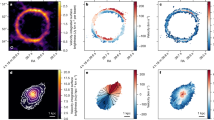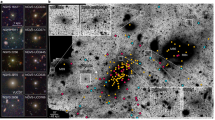Abstract
Observations and theoretical simulations have established a framework for galaxy formation and evolution in the young Universe1,2,3. Galaxies formed as baryonic gas cooled at the centres of collapsing dark-matter haloes; mergers of haloes and galaxies then led to the hierarchical build-up of galaxy mass. It remains unclear, however, over what timescales galaxies were assembled and when and how bulges and disks—the primary components of present-day galaxies—were formed. It is also puzzling that the most massive galaxies were more abundant and were forming stars more rapidly at early epochs than expected from models4,5,6,7. Here we report high-angular-resolution observations of a representative luminous star-forming galaxy when the Universe was only 20% of its current age. A large and massive rotating protodisk is channelling gas towards a growing central stellar bulge hosting an accreting massive black hole. The high surface densities of gas, the high rate of star formation and the moderately young stellar ages suggest rapid assembly, fragmentation and conversion to stars of an initially very gas-rich protodisk, with no obvious evidence for a major merger.
This is a preview of subscription content, access via your institution
Access options
Subscribe to this journal
Receive 51 print issues and online access
$199.00 per year
only $3.90 per issue
Buy this article
- Purchase on Springer Link
- Instant access to full article PDF
Prices may be subject to local taxes which are calculated during checkout



Similar content being viewed by others
References
White, S. D. M. & Rees, M. J. Core condensation in heavy halos—a two-stage theory for galaxy formation and clustering. Mon. Not. R. Astron. Soc. 183, 341–358 (1978)
Davis, M., Efstathiou, G., Frenk, C. S. & White, S. D. M. The evolution of large-scale structure in a universe dominated by cold dark matter. Astrophys. J. 292, 371–394 (1985)
Ellis, R. in Galaxies at High Redshift (eds Perez-Fournon, I., Balcells, M., Moreno-Insertis, F. & Sanchez, F.) 1–28 (Cambridge Univ. Press, Cambridge, 2003)
Fontana, A. et al. The K20 survey. VI. The distribution of the stellar masses in galaxies up to z ≥ 2. Astron. Astrophys. 424, 23–42 (2004)
Chapman, S. C., Blain, A. W., Smail, I. & Ivison, R. J. A redshift survey of the submillimeter galaxy population. Astrophys. J. 622, 772–796 (2005)
Cimatti, A. et al. Old galaxies in the young Universe. Nature 430, 184–187 (2004)
Glazebrook, K. et al. A high abundance of massive galaxies 3–6 billion years after the Big Bang. Nature 430, 181–184 (2004)
Eisenhauer, F. et al. SINFONI—Integral field spectroscopy at 50 milli-arcsecond resolution with the ESO VLT. SPIE 4841, 1548–1561 (2003)
Bonnet, H. et al. First light of SINFONI at the VLT. Messenger 117, 17–24 (2004)
Förster Schreiber, N. M. et al. SINFONI integral field spectroscopy of z∼2 UV-selected galaxies: rotation curves and dynamical evolution. Astrophys. J. 645, 1062–1075 (2006)
Daddi, E. et al. A new photometric technique for the joint selection of star-forming and passive galaxies at 1.4 ≤ z ≤ 2.5. Astrophys. J. 617, 746–764 (2004)
Kong, X. et al. A wide area survey for high-redshift massive galaxies. I. Number counts and clustering of BzKs and EROs. Astrophys. J. 638, 72–87 (2006)
Ganda, K. et al. Late-type galaxies observed with SAURON: two-dimensional stellar and emission-line kinematics of 18 spirals. Mon. Not. R. Astron. Soc. 367, 46–78 (2006)
Daigle, O. et al. α kinematics of the SINGS nearby galaxies survey. I. Mon. Not. R. Astron. Soc. 367, 469–512 (2006)
van der Kruit, P. & Allen, R. The kinematics of spiral and irregular galaxies. Annu. Rev. Astron. Astrophys 16, 103–139 (1978)
Toomre, A. On the gravitational stability of a disk of stars. Astrophys. J. 139, 1217–1238 (1964)
Kennicutt, R. C. The star formation law in galactic disks. Astrophys. J. 644, 685–703 (1989)
Immeli, A., Samland, M., Gerhard, O. & Westera, P. Gas physics, disk fragmentation and bulge formation in young galaxies. Astron. Astrophys. 413, 547–561 (2004)
Kennicutt, R. C. The global Schmidt Law in star-forming galaxies. Astrophys. J. 498, 541–552 (1998)
Kroupa, P. On the variation of the initial mass function. Mon. Not. R. Astron. Soc. 322, 231–246 (2001)
Chabrier, G. Galactic stellar and substellar initial mass function. Publ. Astron. Soc. Pacif. 115, 763–795 (2003)
Tacconi, L. J. et al. High-resolution millimeter imaging of submillimeter galaxies. Astrophys. J. 640, 228–240 (2006)
Dib, S., Bell, E. & Burkert, A. The supernova rate-velocity dispersion relation in the interstellar medium. Astrophys. J. 638, 797–810 (2006)
Thompson, T. A., Quataert, E. & Murray, N. Radiation pressure-supported starburst disks and active galactic nucleus fueling. Astrophys. J. 630, 167–185 (2005)
Monaco, P. Physical regimes for feedback in galaxy formation. Mon. Not. R. Astron. Soc. 352, 181–204 (2004)
Lindblad, P.-O. NGC 1365. Astron. Astrophys. Rev. 9, 221–271 (1999)
D'Onghia, E., Burkert, A., Murante, G. & Khochfar, S. How galaxies lose their angular momentum. Mon. Not. R. Astron. Soc. (submitted); preprint at http://arXiv.org/astro-ph/0602005 (2006)
Yoachim, P. & Dalcanton, J. J. Structural parameters of thin and thick disks in edge-on disk galaxies. Astron. J. 131, 226–249 (2006)
Schreiber, J. et al. in Astronomical Data Analysis Software and Systems (ADASS) XIII (eds Ochsenbein, F., Allen, M. G. & Egret, D.) 380–383 (ASP Conf. Proc. 314, San Francisco, 2004)
Acknowledgements
We thank the SINFONI team members, from the ESO and MPE, for their work, which made these observations possible; the Paranal staff, especially J. Navarrete and P. Amico for their support; and A. Burkert, O. Gerhard and P. Monaco for discussions. A.C. acknowledges support through a Bessel Prize of the Alexander von Humboldt Foundation. This study is based on observations at the Very Large Telescope (VLT) of the ESO, Paranal, Chile.
Author information
Authors and Affiliations
Corresponding author
Ethics declarations
Competing interests
Reprints and permissions information is available at npg.nature.com/reprintsandpermissions. The authors declare no competing financial interests.
Supplementary information
Supplementary Notes
This file contains Supplementary Discussion, Supplementary Figures 1–5 and additional references. (DOC 1291 kb)
Rights and permissions
About this article
Cite this article
Genzel, R., Tacconi, L., Eisenhauer, F. et al. The rapid formation of a large rotating disk galaxy three billion years after the Big Bang. Nature 442, 786–789 (2006). https://doi.org/10.1038/nature05052
Received:
Accepted:
Issue Date:
DOI: https://doi.org/10.1038/nature05052
This article is cited by
-
A Milky Way-like barred spiral galaxy at a redshift of 3
Nature (2023)
-
Strongly baryon-dominated disk galaxies at the peak of galaxy formation ten billion years ago
Nature (2017)
-
Large molecular gas reservoirs in ancestors of Milky Way-mass galaxies nine billion years ago
Nature Astronomy (2016)
-
An extremely young massive clump forming by gravitational collapse in a primordial galaxy
Nature (2015)
-
High velocity dispersion in a rare grand-design spiral galaxy at redshift z = 2.18
Nature (2012)
Comments
By submitting a comment you agree to abide by our Terms and Community Guidelines. If you find something abusive or that does not comply with our terms or guidelines please flag it as inappropriate.



